-
 Iron tsuba of round form decorated with chrysanthemums, pine cones and needles, pampas grass, vines, cherry blossoms, and wild geese in brass inlay (suemon-zōgan) and pierced with designs of water clover (denjiso) and half bellflower (or karahana) to the left and to the right of nakago-ana as well as double bars above and below nakago-ana (possibly with the meaning of number 2 or ordinal 2nd). Most probably the sukashi elements here are the family crests (mon). Unsigned. Ōnin school. Muromachi period; 15th or 16th century. Height: 82.1 mm; Width: 80.9 mm; Thickness at seppa-dai: 2.4 mm NBTHK # 2003827: Tokubetsu Hozon Tosogu Kanteisho (特別保存刀装具鑑定書) - "Extraordinarily Worthy of Preservation".
Iron tsuba of round form decorated with chrysanthemums, pine cones and needles, pampas grass, vines, cherry blossoms, and wild geese in brass inlay (suemon-zōgan) and pierced with designs of water clover (denjiso) and half bellflower (or karahana) to the left and to the right of nakago-ana as well as double bars above and below nakago-ana (possibly with the meaning of number 2 or ordinal 2nd). Most probably the sukashi elements here are the family crests (mon). Unsigned. Ōnin school. Muromachi period; 15th or 16th century. Height: 82.1 mm; Width: 80.9 mm; Thickness at seppa-dai: 2.4 mm NBTHK # 2003827: Tokubetsu Hozon Tosogu Kanteisho (特別保存刀装具鑑定書) - "Extraordinarily Worthy of Preservation". -

Iron tsuba of round form inlaid with brass and shakudo (suemon-zōgan) with a design of tendrils, leaves, double gourds, and folding fan with two wild geese on the face and the same design only with a fan with two interlocked rings (wachigai) on the back. Design is supplemented with a round family crest (mon) of three fans in openwork (sukashi). Hitsu-ana and the mon are outlined with brass rope. Copper sekigane.
Some attribute such tsuba as belonging to Heianjō or even Yoshirō School, and date them to Momoyama period. I keep this piece under Ōnin rubric, late Muromachi, but this is just a question of personal preference.Some inlay is missing, some repaired; traces of rust. Otherwise - decent condition.
Late Muromachi period (1514-1573). Size: 77.4 x 77.1 x 3.8 (center), 3.2 (rim) mm -
 Iron tsuba of mokko form (quatrefoil) decorated with a pair of cherry blossoms (sakura) in small openwork (ko-sukashi) and inlaid in brass (suemon-zōgan) with designs of waves, distant pines, chrysanthemum flowers in halves, tendrils and leaves, lightning or thunder symbol (inazuma), flying geese and family chrests (mon): two interlocked rings (wachigai) on the face, and three encircled stripes (maru-no-uchi-ni-mitsuhikiryo) - kamon of the Kikkawa clan - on the reverse. Hitsu-ana outlined with inlay of brass wire. Surface treated with lacquer. Copper sekigane. Though some consider this type of tsuba to resemble Heianjo school, “...the brass trim around the hitsu-ana is a characteristics of Ōnin work” [Japanese sword guards. Onin – Heianjo – Yoshiro. Gary D. Murtha. GDM Publications, 2016; p. 27.]. The Ōnin origin is reinforced by scattered ten-zōgan elements here and there through the plate. It is possible that the tsuba was initially of round form and later trimmed to mokko shape. Mid Muromachi period; 15th century. Dimensions: Height: 87.2 mm; Width: 87.9 mm; Thickness at seppa-dai: 3.6 mm.
Iron tsuba of mokko form (quatrefoil) decorated with a pair of cherry blossoms (sakura) in small openwork (ko-sukashi) and inlaid in brass (suemon-zōgan) with designs of waves, distant pines, chrysanthemum flowers in halves, tendrils and leaves, lightning or thunder symbol (inazuma), flying geese and family chrests (mon): two interlocked rings (wachigai) on the face, and three encircled stripes (maru-no-uchi-ni-mitsuhikiryo) - kamon of the Kikkawa clan - on the reverse. Hitsu-ana outlined with inlay of brass wire. Surface treated with lacquer. Copper sekigane. Though some consider this type of tsuba to resemble Heianjo school, “...the brass trim around the hitsu-ana is a characteristics of Ōnin work” [Japanese sword guards. Onin – Heianjo – Yoshiro. Gary D. Murtha. GDM Publications, 2016; p. 27.]. The Ōnin origin is reinforced by scattered ten-zōgan elements here and there through the plate. It is possible that the tsuba was initially of round form and later trimmed to mokko shape. Mid Muromachi period; 15th century. Dimensions: Height: 87.2 mm; Width: 87.9 mm; Thickness at seppa-dai: 3.6 mm. -
 Thin iron tsuba of round form with design of family crests (mon) and arabesque (karakusa) in brass or copper inlay (suemon-zōgan) and occasional scattered brass dots or nail heads in ten-zōgan. Seppa-dai outlined with brass wire in the shape of a rope; kozuka-hitsu-ana outlined with scalloped brass wire. Rounded rim with iron bones (tekkotsu). The surface covered with lacquer (urushi). Ōnin school. Late Muromachi period, 16th century. Family crests on the face: 1:30: Two lines (double stripe) encircled (maruni futatsu biki). 4:30: Stylized clove (choji). 7:30: Divided rhombus, or four lozenges incorporated in one (wari-bishi); it is also called Takeda-bishi, the family crest of warrior Takeda Shingen (among the others). 10:00: Stylized Genji-mon (Genji kō-zu) or incense symbol. On the reverse: 2:00 - "Chinese cloud" not a crest. 5:00: Bit (Kutsuwa) 7:30: Number four in a fan (ōgi-san) 10:30: Two dots in a well frame (igeta).
Thin iron tsuba of round form with design of family crests (mon) and arabesque (karakusa) in brass or copper inlay (suemon-zōgan) and occasional scattered brass dots or nail heads in ten-zōgan. Seppa-dai outlined with brass wire in the shape of a rope; kozuka-hitsu-ana outlined with scalloped brass wire. Rounded rim with iron bones (tekkotsu). The surface covered with lacquer (urushi). Ōnin school. Late Muromachi period, 16th century. Family crests on the face: 1:30: Two lines (double stripe) encircled (maruni futatsu biki). 4:30: Stylized clove (choji). 7:30: Divided rhombus, or four lozenges incorporated in one (wari-bishi); it is also called Takeda-bishi, the family crest of warrior Takeda Shingen (among the others). 10:00: Stylized Genji-mon (Genji kō-zu) or incense symbol. On the reverse: 2:00 - "Chinese cloud" not a crest. 5:00: Bit (Kutsuwa) 7:30: Number four in a fan (ōgi-san) 10:30: Two dots in a well frame (igeta). -
 Iron tsuba of round form profusely decorated with brass inlay of plants, birds, well, and family crests (mon) in suemon-zōgan technique and occasional brass dots (nail-heads) or ten-zōgan. Seppa-dai and kozuka-hitsu-ana outlined with brass inaly, possibly repaired: rope-shaped wire here and there replaced with flat wire. The plate is very thin, with remnants of lacquer. Ōnin school. Size: 75.8 x 75.2 x 2.3 mm. Weight: 77.5 g. On the front side (omote) motif includes the following elements (from 12 o'clock, clockwise):
Iron tsuba of round form profusely decorated with brass inlay of plants, birds, well, and family crests (mon) in suemon-zōgan technique and occasional brass dots (nail-heads) or ten-zōgan. Seppa-dai and kozuka-hitsu-ana outlined with brass inaly, possibly repaired: rope-shaped wire here and there replaced with flat wire. The plate is very thin, with remnants of lacquer. Ōnin school. Size: 75.8 x 75.2 x 2.3 mm. Weight: 77.5 g. On the front side (omote) motif includes the following elements (from 12 o'clock, clockwise):- Water plantain (a.k.a. arrowhead, or omodaka): "a perpetual plant of the water plantain family, was also called shōgunsō (victorious army grass). Because of this martial connotation, it was a design favored for the crests of samurai families" [see: Family Crests of Japan. // Stone Bridge Press, Berkeley, CA, 2007; p. 63].
- Heron (sagi): "...considered an emblem of longevity, and from China comes the practice of regarding the bird as a mount of the gods and the Taoist sennin. [...] heron also reflects an inauspicious connotation, for the word sagi is homophone for 'fraud' and 'false pretenses'." [see: Merrily Baird. Symbols of Japan. Thematic motifs in art and design. // Rizzoli international publications, Inc., 2001; p. 112]. Some may say, that this is not a heron but a crane (tsuru). It's very possible, and in this case the negative connotation is lost, but the reference to longevity and allusion to sennin remain.
- Pampas grass (susuki, or obana): as per Merrily Baird, p. 95 and John W. Dower, p. 66, pampas grass is one of the Seven Grasses of Autumn. When combined with flying wild gees, conveys strong autumnal mood.
- Plum blossom (ume): according to Merrily Baird, the flower has a vast variety of symbolic meanings, including longevity, and a reference to the Chinese Taoists. It is used in 80 family crests [see: Japanese Design Motifs: 4,260 Illustrations of Japanese Crests; Compiled by the Matsuya Piece-Goods Store; Translated by Fumie Adachi. // Dover Publications, Inc., 1972.] Plum is "celebrated for its sweet perfume, delicate blossoms, and habit of blooming at the end of winter".
- Tree flying wild geese (kari): "Wild geese arrive in large flocks in southern regions during the autumn months, and following their migratory instincts, head back north in spring" [Family Crests of Japan, pp. 85-86]. "The importance of geese in Japanese art was further secured by stories of several military heroes who had achieved victory in battle when a sudden breaking of ranks by flying geese signaled an ambush. The protective role of the birds led to their frequent use in decorating sword furnishings and possibly also their adoption as a family crest motif.Finally, the goose in Asia plays a role in religious traditions" [Merrily Baird, pp.111-112].
- Hikiryō (line, or bar, or stripe) - a symbol which consists of one, two, or three horizontal or vertical stripes in a circle. "In wartime, Japanese generals [...] surrounded their encampments with huge cloth curtains. Usually these were made of cloth sewn together horizontally and varying in color [...] to distinguish the individual general and his followers. The stripe thus assumed strong martial connotations, and became a mark of identification on personal military gear as well. In the early fourteenth century the heads of the Ashikaga and Nitta, then the two most powerful clans in Japan, both adopted stripe patterns as a family crest". [See: Family Crests of Japan, p. 111 and John W. Dower. The elements of Japanese design - A handbook of family crests, heraldry & symbolism. // Weatherhill, New York, Tokyo, 1985, p. 144].
- Hikiryō, see above.
- Pampas grass (susuki, or obana), see above.
- Bellflower (kikyo): One of the Seven Grasses of Autumn. "As a crest, it have been adopted among the warriors around the thirteenth century, primarily because of it's beauty" [John W. Dower, p. 48].
- Four flying wild geese (kari), see above.
- Weeping willow (yanagi): "It is commonly represented with water, snow, swallows, or herons. A branch of willow (yoshi) is one of the attributes of the Buddhist deity Senju Kannon (Thousand-Armed Kannon), who is said to use the branch to sprinkle the nectar of life contained in a vase. [Merrily Baird, pp. 66-67].
- Lone plum blossom in a well frame/crib (igeta, izitsu): "Well crib was one of the most popular motifs in Japanese heraldry". As a crest it may stay simply for the first character (i) of the family name, however, with a flower inside the well frame, and together with the other symbols present, it may aggravate the sense of autumn-ness. The ten-zōgan dots in this particular case may represent the snowflakes or autumn stars.
-
 Iron tsuba of round form, slightly convex, decorated with persimmon (kaki), simplified Genji-kō (incense game symbol) and halves of plum blossoms (ume) in brass inlay on both sides, and with part of bellflower (kikyo) in openwork. Outer rim, seppa-dai, bellflower openwork, and kozuka-ana outlined with brass inlay; traces of lacquer to surface. The symbolic meaning alludes to Chapter 20: Asagao (朝顔, the bellflower or "morning face") of Tale of Genji by Murasaki Shikibu (11th century AD). The events take place in the 9th lunar month (Nagatsuki) and involve the following poetry by Prince Genji: saku hana ni / utsuru chō na wa / tsutsumedomo / orade sugiuki / kesa no asagao [I would not have it said / that my heart has turned toward / a flower in bloom — / yet how hard it is to pass / without plucking a “morning face”!]. Measurements: H: 76.6 mm; W: 76.3 mm; Th.: 3.6 mm (seppa-dai), 3.0 mm (rim) Time: Late Muromachi (1514 – 1573).
Iron tsuba of round form, slightly convex, decorated with persimmon (kaki), simplified Genji-kō (incense game symbol) and halves of plum blossoms (ume) in brass inlay on both sides, and with part of bellflower (kikyo) in openwork. Outer rim, seppa-dai, bellflower openwork, and kozuka-ana outlined with brass inlay; traces of lacquer to surface. The symbolic meaning alludes to Chapter 20: Asagao (朝顔, the bellflower or "morning face") of Tale of Genji by Murasaki Shikibu (11th century AD). The events take place in the 9th lunar month (Nagatsuki) and involve the following poetry by Prince Genji: saku hana ni / utsuru chō na wa / tsutsumedomo / orade sugiuki / kesa no asagao [I would not have it said / that my heart has turned toward / a flower in bloom — / yet how hard it is to pass / without plucking a “morning face”!]. Measurements: H: 76.6 mm; W: 76.3 mm; Th.: 3.6 mm (seppa-dai), 3.0 mm (rim) Time: Late Muromachi (1514 – 1573). -
 Iron tsuba of quatrefoil form (mokka-gata) adorned with the design of stars, wild geese, blossoms, leaves and tendrils realized in the brass inlay. The inlay technique includes suemon-zōgan and ten-zōgan. A smaller opening (kozuka hitsu-ana) surrounded by a scalloped brass border. The seppa-dai bordered with linear inlay. A few dots of inlay on both sides are missing. Measurements: height 71 mm, width 70 mm, thickness at centre 2.7 cm Time: Late Muromachi (1514 – 1573)
Iron tsuba of quatrefoil form (mokka-gata) adorned with the design of stars, wild geese, blossoms, leaves and tendrils realized in the brass inlay. The inlay technique includes suemon-zōgan and ten-zōgan. A smaller opening (kozuka hitsu-ana) surrounded by a scalloped brass border. The seppa-dai bordered with linear inlay. A few dots of inlay on both sides are missing. Measurements: height 71 mm, width 70 mm, thickness at centre 2.7 cm Time: Late Muromachi (1514 – 1573) -
 Iron tsuba of a round form (maru-gata) pierced (sukashi) with two six-petal flowers at 6 and 12 o’clock and modified lozenges at 3 and 9 o’clock, and inlaid in brass (suemon-zōgan) with tendrils and flowers (chrysanthemum, cherry blossom, Chinese bellflower, paulownia); openings outlined with scalloped brass wire. The plate is slightly concave with traces of lacquer on the surface. Nakago-ana plugged with copper sekigane. Some elements of inlay missing. The rim with conspicuous tekkotsu, quite worn. Measurements: Height 92.0 mm; Width 86.3 mm; thickness at seppa-dai 3.2 mm, at rim 4.2 mm. Time: Late Muromachi (1514 – 1573) or earlier.
Iron tsuba of a round form (maru-gata) pierced (sukashi) with two six-petal flowers at 6 and 12 o’clock and modified lozenges at 3 and 9 o’clock, and inlaid in brass (suemon-zōgan) with tendrils and flowers (chrysanthemum, cherry blossom, Chinese bellflower, paulownia); openings outlined with scalloped brass wire. The plate is slightly concave with traces of lacquer on the surface. Nakago-ana plugged with copper sekigane. Some elements of inlay missing. The rim with conspicuous tekkotsu, quite worn. Measurements: Height 92.0 mm; Width 86.3 mm; thickness at seppa-dai 3.2 mm, at rim 4.2 mm. Time: Late Muromachi (1514 – 1573) or earlier. -
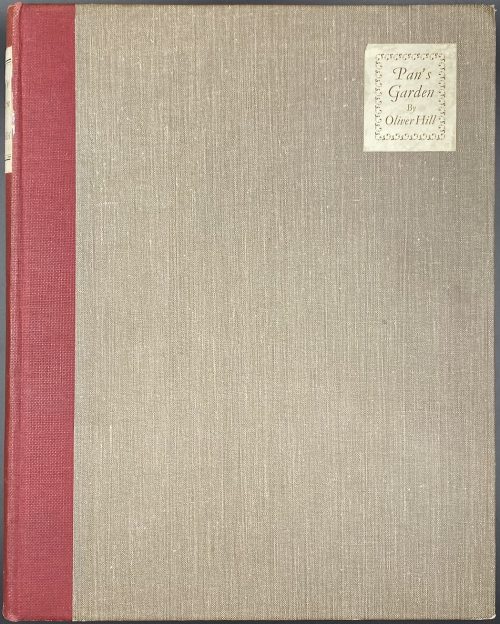 Description: Hardcover photographic pictorial album, 29.2 x 23.1 cm, quarter crimson percaline over grey cloth with lettered paper labels to front cover and spine, grey endpapers; pp. [1-4] 5-109 [3], total 56 leaves, additional spine and cover labels tipped-in. Oliver Hill (British, 1887 – 1968).
Description: Hardcover photographic pictorial album, 29.2 x 23.1 cm, quarter crimson percaline over grey cloth with lettered paper labels to front cover and spine, grey endpapers; pp. [1-4] 5-109 [3], total 56 leaves, additional spine and cover labels tipped-in. Oliver Hill (British, 1887 – 1968). -
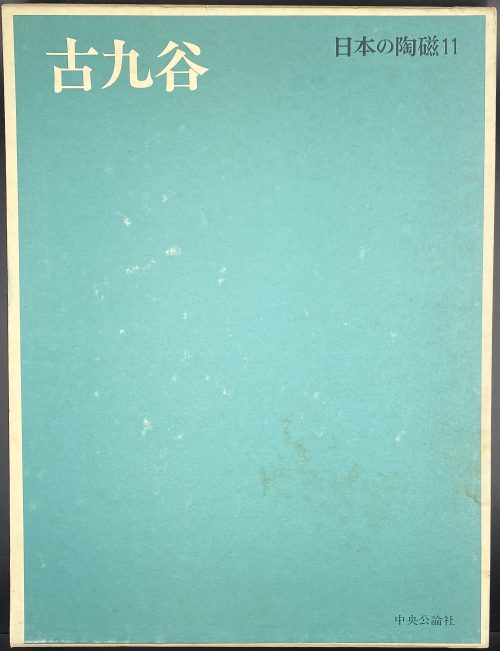 Hardcover volume, 35 x 26.8 cm, bound in grey cloth, blind stamped characters to front, brown characters to spine, in a slipcase, the outer case missing, pp.: [4] [1] 2-136 (plates with photographs of 211 items), [2] 139-166 [4]. Kutani ware [九谷焼] (Kutani-yaki); old kutani [古九谷] (kokutani) – ceramic objects produced in Kutani in the 17th century. 日本の陶磁 – Japanese ceramics, series title. Contributors: Yasunari Kawabata [川端 康成] (Japanese, 1924 – 1972) – author. Tetsuzo Tanikawa [谷川 徹三] (Japanese, 1895 – 1989) – author. Seizo Hayashiya [林屋晴三] (Japanese, 1928 – 2017) – editor. Chūōkōron-sha [中央公論社] – publisher.
Hardcover volume, 35 x 26.8 cm, bound in grey cloth, blind stamped characters to front, brown characters to spine, in a slipcase, the outer case missing, pp.: [4] [1] 2-136 (plates with photographs of 211 items), [2] 139-166 [4]. Kutani ware [九谷焼] (Kutani-yaki); old kutani [古九谷] (kokutani) – ceramic objects produced in Kutani in the 17th century. 日本の陶磁 – Japanese ceramics, series title. Contributors: Yasunari Kawabata [川端 康成] (Japanese, 1924 – 1972) – author. Tetsuzo Tanikawa [谷川 徹三] (Japanese, 1895 – 1989) – author. Seizo Hayashiya [林屋晴三] (Japanese, 1928 – 2017) – editor. Chūōkōron-sha [中央公論社] – publisher. -
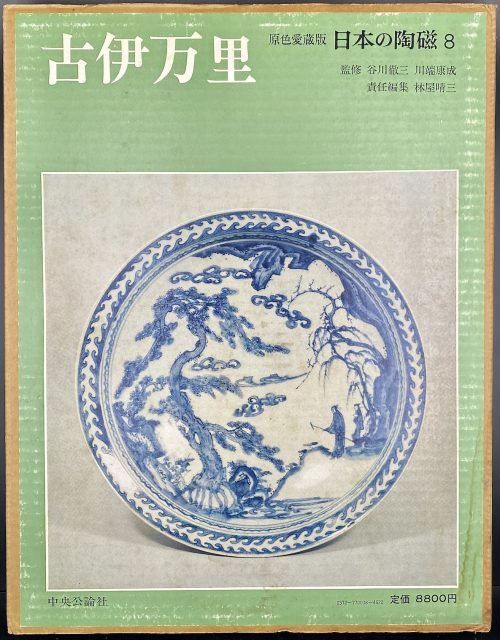 Hardcover volume, 35.1 x 27 cm, bound in grey cloth, blind stamped characters to front, brown characters to spine, in a glassine dust jacket, in a double slipcase, the outer case pictorial paper over cardboard, 36 x 27.8 cm, pp.: [4] [1] 2-108 (plates with photographs of 217 items), [2] [111] 112-150 [3]. Imari ware [伊万里焼] (Imari-yaki) – ceramics produced in and around the area of Arita, in the former Hizen Province, northwestern Kyūshū. 日本の陶磁 – Japanese ceramics, series title. Old imari [古伊万里] (koimari) – book title. Contributors: Yasunari Kawabata [川端 康成] (Japanese, 1924 – 1972) – author. Tetsuzo Tanikawa [谷川 徹三] (Japanese, 1895 – 1989) – author. Seizo Hayashiya [林屋晴三] (Japanese, 1928 – 2017) – editor. Chūōkōron-sha [中央公論社] – publisher.
Hardcover volume, 35.1 x 27 cm, bound in grey cloth, blind stamped characters to front, brown characters to spine, in a glassine dust jacket, in a double slipcase, the outer case pictorial paper over cardboard, 36 x 27.8 cm, pp.: [4] [1] 2-108 (plates with photographs of 217 items), [2] [111] 112-150 [3]. Imari ware [伊万里焼] (Imari-yaki) – ceramics produced in and around the area of Arita, in the former Hizen Province, northwestern Kyūshū. 日本の陶磁 – Japanese ceramics, series title. Old imari [古伊万里] (koimari) – book title. Contributors: Yasunari Kawabata [川端 康成] (Japanese, 1924 – 1972) – author. Tetsuzo Tanikawa [谷川 徹三] (Japanese, 1895 – 1989) – author. Seizo Hayashiya [林屋晴三] (Japanese, 1928 – 2017) – editor. Chūōkōron-sha [中央公論社] – publisher. -
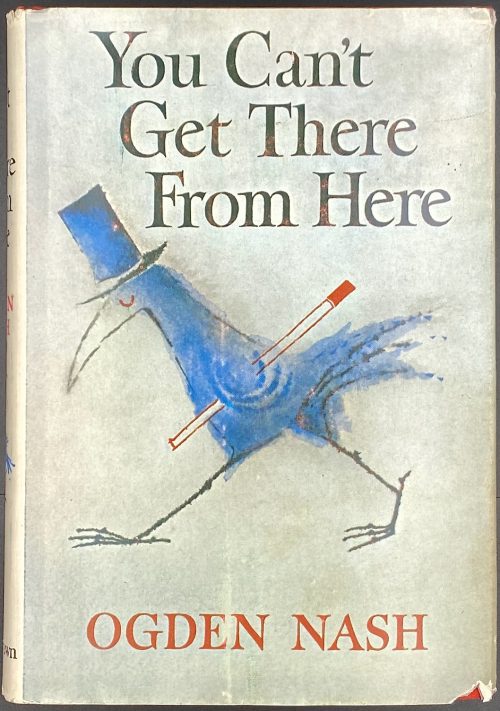 Description: In-8vo volume, 19.4 x 14 cm, bound in red cloth with gilt lettering to front cover and spine, in a pictorial dust jacket with a photo portrait of the author by Kay Bell to the rear, DJ and in-text illustrations by Maurice Sendak; pp. [i-x] xi-xvii [xviii] [2] 3-190, total 208 pages. Dust Jacket front: You Can't | Get There | From Here | {vignette} | OGDEN NASH || Title-page: OGDEN NASH | You Can't Get There | From Here | {vignettes} | DRAWINGS BY MAURICE SENDAK | Boston • LITTLE, BROWN AND COMPANY • Toronto || Edition: 1957, 8th printing; (1st edition in 1953) Contributors: Ogden Nash (American, 1902 – 1971) – author. Maurice Sendak (Jewish-American, 1928 – 2012) – artist. Kay Bell Reynal (American, 1905 – 1977) – photographer.
Description: In-8vo volume, 19.4 x 14 cm, bound in red cloth with gilt lettering to front cover and spine, in a pictorial dust jacket with a photo portrait of the author by Kay Bell to the rear, DJ and in-text illustrations by Maurice Sendak; pp. [i-x] xi-xvii [xviii] [2] 3-190, total 208 pages. Dust Jacket front: You Can't | Get There | From Here | {vignette} | OGDEN NASH || Title-page: OGDEN NASH | You Can't Get There | From Here | {vignettes} | DRAWINGS BY MAURICE SENDAK | Boston • LITTLE, BROWN AND COMPANY • Toronto || Edition: 1957, 8th printing; (1st edition in 1953) Contributors: Ogden Nash (American, 1902 – 1971) – author. Maurice Sendak (Jewish-American, 1928 – 2012) – artist. Kay Bell Reynal (American, 1905 – 1977) – photographer. -
 Ogata Gekkō [尾形月耕] (Japanese, 1859 – 1920). An uchiwa-e (fan-print) of advertisement of tobacco of Kagoshima Prefecture, c. 1890 (Meiji Period). Barefoot Tengu* is sitting on a torii (entrance to a Shinto shrine), smoking a cigarette through a mouthpiece. _______ * Tengu [天狗] (heavenly dog) is a type of legendary creature found in Japanese folk religion and are also considered a type of Shinto god (kami) or yōkai (supernatural beings).
Ogata Gekkō [尾形月耕] (Japanese, 1859 – 1920). An uchiwa-e (fan-print) of advertisement of tobacco of Kagoshima Prefecture, c. 1890 (Meiji Period). Barefoot Tengu* is sitting on a torii (entrance to a Shinto shrine), smoking a cigarette through a mouthpiece. _______ * Tengu [天狗] (heavenly dog) is a type of legendary creature found in Japanese folk religion and are also considered a type of Shinto god (kami) or yōkai (supernatural beings). -
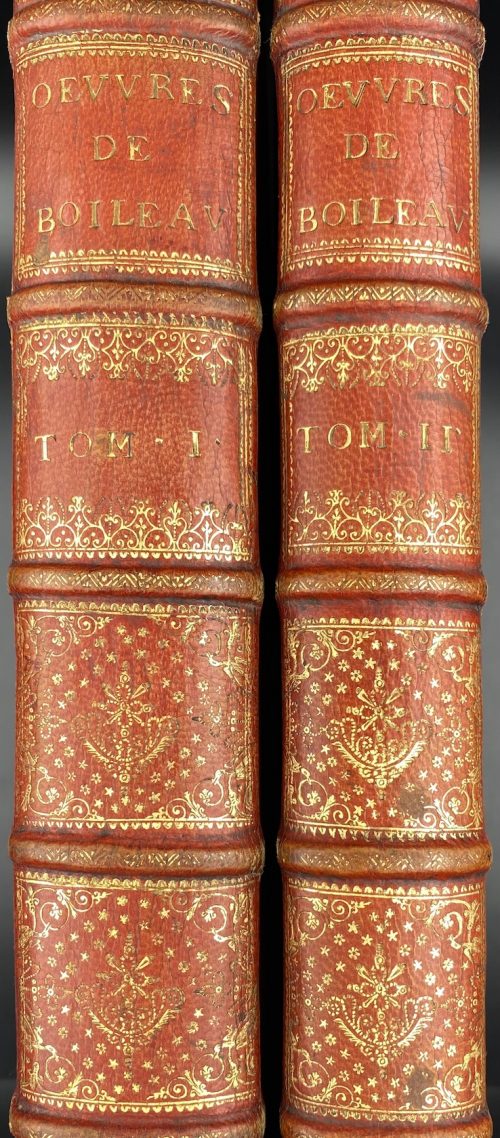 Description: two volumes, 38.3 x 25.5 cm each, uniformly bound in red morocco, boards decorated in gilt in the style of Luc-Antoine Boyet, with gilt dentelle inside out; spine with raised bands, gilt lettering, gilt in compartments; all edges gilt; marbled endpapers; printed on laid paper, text in the floral frame, engraved frontispiece (after Hyacinthe Rigaud), plates, t.p. vignette with the portrait of Desiderius Erasmus (after Quentin Metsys), head- and tailpieces (total of 40, some repeating) and 2 initials by Bernard Picart, folded portrait of dedicatee Guillelmine Charlotte Princesse de Galles &c &c &c by van Gunst after Kneller. Title-page (red and black, tall ‘s’): OEUVRES | DE | NICOLAS BOILEAU | DESPRÉAUX. | AVEC DES | ÉCLAIRCISSEMENTS | HISTORIQUES, | DONNEZ PAR LUI-MEME. | Nouvelle Edition revuë, corrigée & augmentée de diverses Remarques. | Enrichie de figures gravées par Bernard Picart le Romain. | TOME PREMIER (SECOND). | {vignette} | A AMSTERDAM, | Chez DAVID MORTIER. | — | M DCCXVIII. | AVEC PRIVILEGE. || Vol. 1. Collation: 4to; 1 ffl, a-c4 d1 A-3K4, 3L2, 1ffl; (K3 marked I3). Plates: t.p. vignette, frontispiece, 24 head- and tailpieces, f.t. in a grotesque frame and 6 full-page for ‘Le Lutrin’ in the same frame by Bernard Picart; folded portrait of Guillelmine Charlotte, Princess of Wales by van Gunst after Kneller. Pagination: [4] [i-v] vi-xviii [4] [1] 2-450 [2]. Vol. 2. Collation: 4to; 2 ffl, π2 A-3C4 3D3 2 ffl; (V3 marked T3, 2L4 marked A). Plates: t.p. vignette (same as vol.1) and 7 head- and tailpieces by Bernard Picart. Pagination: [4] [i-iii] iv-vii [viii] [1] 2-370 [2] [20]. Catalogue raisonné: Lewine 72-3; Cohen-De Ricci 165-6. Contributors: Luc-Antoine Boyet (French, fl. 1684 – 1733) – bookbinder. Claude Brossette (French, 1671 – 1743) – author, remarks. André Dacier (French, 1651 – 1722) – author, preface. Nicolas Boileau Despréaux (French, 1636 – 1711) – author. Pieter Stevens van Gunst (Dutch, 1659-1724) – engraver. Sir Godfrey Kneller (British, 1646-1723) – artist. David Mortier (Dutch-British, 1673 – 1728) – publisher. Bernard Picard (French, 1673 – 1733) – artist, engraver. Quentin Massijs [Metsys, Matsys] (Flemish, 1466 – 1530) – artist. Hyacinthe Rigaud [Jacint Rigau-Ros i Serra] (French, 1659 - 1743) – artist. Guillelmine Charlotte, Princess of Wales (Wilhelmina Charlotte Caroline of Brandenburg-Ansbach) (1683 – 1737) – dedicatee
Description: two volumes, 38.3 x 25.5 cm each, uniformly bound in red morocco, boards decorated in gilt in the style of Luc-Antoine Boyet, with gilt dentelle inside out; spine with raised bands, gilt lettering, gilt in compartments; all edges gilt; marbled endpapers; printed on laid paper, text in the floral frame, engraved frontispiece (after Hyacinthe Rigaud), plates, t.p. vignette with the portrait of Desiderius Erasmus (after Quentin Metsys), head- and tailpieces (total of 40, some repeating) and 2 initials by Bernard Picart, folded portrait of dedicatee Guillelmine Charlotte Princesse de Galles &c &c &c by van Gunst after Kneller. Title-page (red and black, tall ‘s’): OEUVRES | DE | NICOLAS BOILEAU | DESPRÉAUX. | AVEC DES | ÉCLAIRCISSEMENTS | HISTORIQUES, | DONNEZ PAR LUI-MEME. | Nouvelle Edition revuë, corrigée & augmentée de diverses Remarques. | Enrichie de figures gravées par Bernard Picart le Romain. | TOME PREMIER (SECOND). | {vignette} | A AMSTERDAM, | Chez DAVID MORTIER. | — | M DCCXVIII. | AVEC PRIVILEGE. || Vol. 1. Collation: 4to; 1 ffl, a-c4 d1 A-3K4, 3L2, 1ffl; (K3 marked I3). Plates: t.p. vignette, frontispiece, 24 head- and tailpieces, f.t. in a grotesque frame and 6 full-page for ‘Le Lutrin’ in the same frame by Bernard Picart; folded portrait of Guillelmine Charlotte, Princess of Wales by van Gunst after Kneller. Pagination: [4] [i-v] vi-xviii [4] [1] 2-450 [2]. Vol. 2. Collation: 4to; 2 ffl, π2 A-3C4 3D3 2 ffl; (V3 marked T3, 2L4 marked A). Plates: t.p. vignette (same as vol.1) and 7 head- and tailpieces by Bernard Picart. Pagination: [4] [i-iii] iv-vii [viii] [1] 2-370 [2] [20]. Catalogue raisonné: Lewine 72-3; Cohen-De Ricci 165-6. Contributors: Luc-Antoine Boyet (French, fl. 1684 – 1733) – bookbinder. Claude Brossette (French, 1671 – 1743) – author, remarks. André Dacier (French, 1651 – 1722) – author, preface. Nicolas Boileau Despréaux (French, 1636 – 1711) – author. Pieter Stevens van Gunst (Dutch, 1659-1724) – engraver. Sir Godfrey Kneller (British, 1646-1723) – artist. David Mortier (Dutch-British, 1673 – 1728) – publisher. Bernard Picard (French, 1673 – 1733) – artist, engraver. Quentin Massijs [Metsys, Matsys] (Flemish, 1466 – 1530) – artist. Hyacinthe Rigaud [Jacint Rigau-Ros i Serra] (French, 1659 - 1743) – artist. Guillelmine Charlotte, Princess of Wales (Wilhelmina Charlotte Caroline of Brandenburg-Ansbach) (1683 – 1737) – dedicatee -

Large iron tsuba with hammer marks on the surface, small oval opening to the right of nakaga-ana; yamagane fukurin chiselled with tortois shell diaper pattern.
Early Muromachi period (1393-1453). Size: 101.2 x 101.9 x 2.4 (center), 5.2 (rim) mm; weight: 148.4 g. -
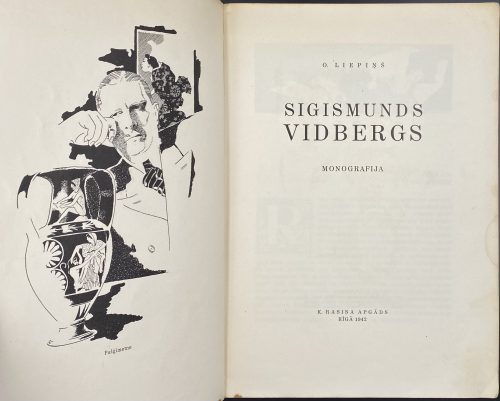 Publisher’s original wrappers, with VIDBERGS to front (bordered) and to spine, size 25 x 18 cm. Title page: O. LIEPIŅŠ | SIGISMUNDS | VIDBERGS | MONOGRAFIJA | K. RASIŅA APGĀDS | RIGĀ 1942 || Imprint: ATTĒLI MĀKSLINIEKA IZRAUDZĪTI UN SAKĀRTOTI (pictures selected and arranged by the artist) Pagination: [1-6] (incl. 1st blank leaf), 7-149 [150] [2] blank; 44 pages of text with in-text illustrations, pp. 47-149 – plates on odd pages, titles on even pages, 51 full-page illustrations. Circulation: 4,000 copies. Contributors: Liepiņš, Olģerts (Latvian, 1906 – 1983) – author. Sigismunds Vidbergs (Latvian-American, 1890 – 1970) – artist. Kārlis Rasiņš (Latvian, 1886 – 1974) – publisher.
Publisher’s original wrappers, with VIDBERGS to front (bordered) and to spine, size 25 x 18 cm. Title page: O. LIEPIŅŠ | SIGISMUNDS | VIDBERGS | MONOGRAFIJA | K. RASIŅA APGĀDS | RIGĀ 1942 || Imprint: ATTĒLI MĀKSLINIEKA IZRAUDZĪTI UN SAKĀRTOTI (pictures selected and arranged by the artist) Pagination: [1-6] (incl. 1st blank leaf), 7-149 [150] [2] blank; 44 pages of text with in-text illustrations, pp. 47-149 – plates on odd pages, titles on even pages, 51 full-page illustrations. Circulation: 4,000 copies. Contributors: Liepiņš, Olģerts (Latvian, 1906 – 1983) – author. Sigismunds Vidbergs (Latvian-American, 1890 – 1970) – artist. Kārlis Rasiņš (Latvian, 1886 – 1974) – publisher. -
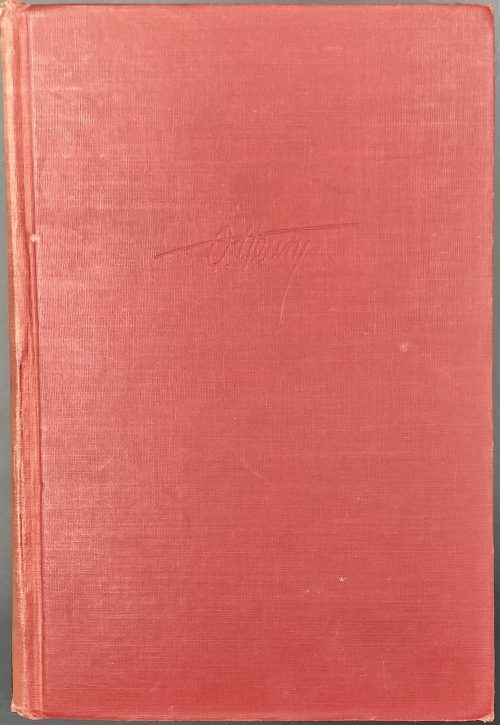 Hardcover volume, 21.5 x 14.7 x 5.7 cm, bound in red cloth with blind-stamped ms signature to front board and gilt lettering over black labels, and gild design elements to spine; pp.: [i-iv] (h.t./blank, t.p./copyright) v-xv[xvi] blank, [1-2] f.t./blank, 3-1653 [1654] blank, [2] publ. note/blank; 1672 pp total; Blue ink ms inscription to h.t. 'Lawrence Wyman'. Title-page (in a two-rule frame): THE COMPLETE WORKS OF | O. Henry | Foreword by | WILLIAM LYON PHELPS | AUTHENTIC EDITION | {publisher’s device, G.C.P.} | De Luxe Edition | — | Garden City Publishing Co., Inc. | GARDEN CITY NEW YORK || Contributors: O. Henry [William Sydney Porter] (American, 1862 – 1910) – author. William Lyon Phelps (American, 1865 – 1943) – author/foreword.
Hardcover volume, 21.5 x 14.7 x 5.7 cm, bound in red cloth with blind-stamped ms signature to front board and gilt lettering over black labels, and gild design elements to spine; pp.: [i-iv] (h.t./blank, t.p./copyright) v-xv[xvi] blank, [1-2] f.t./blank, 3-1653 [1654] blank, [2] publ. note/blank; 1672 pp total; Blue ink ms inscription to h.t. 'Lawrence Wyman'. Title-page (in a two-rule frame): THE COMPLETE WORKS OF | O. Henry | Foreword by | WILLIAM LYON PHELPS | AUTHENTIC EDITION | {publisher’s device, G.C.P.} | De Luxe Edition | — | Garden City Publishing Co., Inc. | GARDEN CITY NEW YORK || Contributors: O. Henry [William Sydney Porter] (American, 1862 – 1910) – author. William Lyon Phelps (American, 1865 – 1943) – author/foreword. -
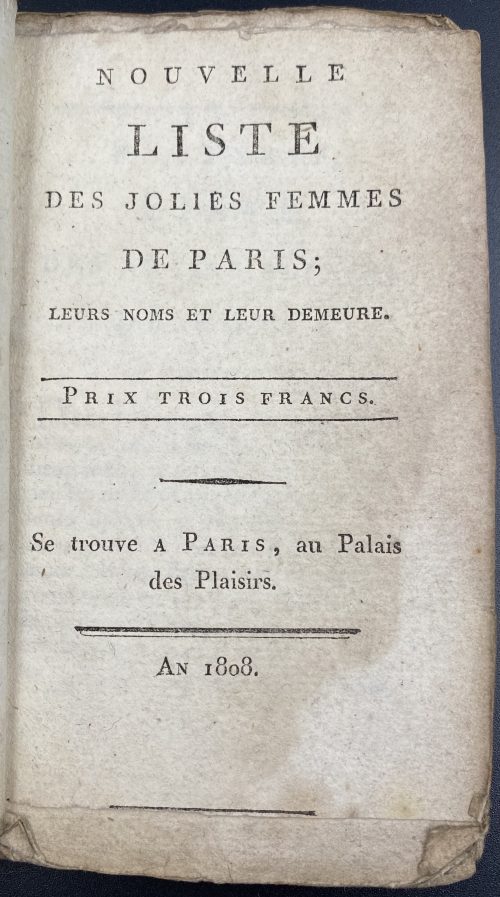 Title: NOUVELLE | LISTE | DES JOLIES FEMMES | DE PARIS ; | LEURS NOMS ET LEUR DEMEURE. | PRIX TROIS FRANCS. | Se trouve A Paris , au Palais des plaisirs. | — | An 1808. || Pagination : [1-6] 7-70 [2 blank] Collation : 9vo, [A]9 B-D9. Binding: Original blue wrappers, 15 x 9 cm. Ref: OCLC finds only one copy, at the British Library. The BnF has a work of the same title, with the same pagination, dated 1803. The stated publisher seems to be fictitious. Quaritch description: 12mo, pp. 70; a little dusty, a few spots and marks; a very good uncut copy in original blue/grey wrappers; somewhat worn and stained. Very rare guide to Parisian prostitutes providing an extraordinary snapshot of the state of prostitution in the city during the First French Empire. The anonymous compiler begins with a brief history of prostitution in the capital, and its regulation, under Charlemagne and Louis VIII, describes a brothel established by Joanna I of Naples at Avignon and discusses Pierre-Jean Grosley’s estimate of the number of prostitutes in London. He then provides his liste, divided into categories including ‘houses of the first order’, ‘bawdy houses’, ‘actresses’, ‘washerwomen’, and ‘procuresses’, giving the name of each prostitute, an indication of their age, and their physical attributes, character, and particular talents. Rosanne, for example, chez Madame l’Évêque at the Palais du Tribunat, offers ‘unspeakably voluptuous pleasures to the nether regions’; Honorine prefers women; Scholastique likes wine with her lovemaking; Nanette has a penchant for soldiers; Genevieve favours the priapic; Dorsay enjoys S&M, and Madame Laperriere promises rejuvenation to the elderly. One Ducroisy is poetically described as possessing ‘a tuft as black as a crow above two alabaster columns’, while Félicité has skin ‘soft and white, sprinkled with golden freckles, like gold in Maraschino liqueur’. The author hopes that his listed will bring business to the ladies and pleasure to their clients, beseeching both to look after their health so that his guide might ‘serve Love, not Asclepius’.
Title: NOUVELLE | LISTE | DES JOLIES FEMMES | DE PARIS ; | LEURS NOMS ET LEUR DEMEURE. | PRIX TROIS FRANCS. | Se trouve A Paris , au Palais des plaisirs. | — | An 1808. || Pagination : [1-6] 7-70 [2 blank] Collation : 9vo, [A]9 B-D9. Binding: Original blue wrappers, 15 x 9 cm. Ref: OCLC finds only one copy, at the British Library. The BnF has a work of the same title, with the same pagination, dated 1803. The stated publisher seems to be fictitious. Quaritch description: 12mo, pp. 70; a little dusty, a few spots and marks; a very good uncut copy in original blue/grey wrappers; somewhat worn and stained. Very rare guide to Parisian prostitutes providing an extraordinary snapshot of the state of prostitution in the city during the First French Empire. The anonymous compiler begins with a brief history of prostitution in the capital, and its regulation, under Charlemagne and Louis VIII, describes a brothel established by Joanna I of Naples at Avignon and discusses Pierre-Jean Grosley’s estimate of the number of prostitutes in London. He then provides his liste, divided into categories including ‘houses of the first order’, ‘bawdy houses’, ‘actresses’, ‘washerwomen’, and ‘procuresses’, giving the name of each prostitute, an indication of their age, and their physical attributes, character, and particular talents. Rosanne, for example, chez Madame l’Évêque at the Palais du Tribunat, offers ‘unspeakably voluptuous pleasures to the nether regions’; Honorine prefers women; Scholastique likes wine with her lovemaking; Nanette has a penchant for soldiers; Genevieve favours the priapic; Dorsay enjoys S&M, and Madame Laperriere promises rejuvenation to the elderly. One Ducroisy is poetically described as possessing ‘a tuft as black as a crow above two alabaster columns’, while Félicité has skin ‘soft and white, sprinkled with golden freckles, like gold in Maraschino liqueur’. The author hopes that his listed will bring business to the ladies and pleasure to their clients, beseeching both to look after their health so that his guide might ‘serve Love, not Asclepius’.


